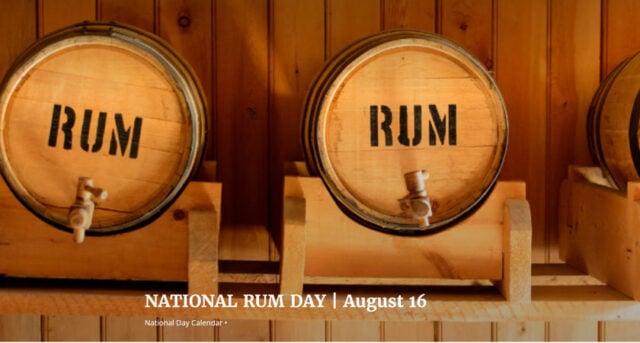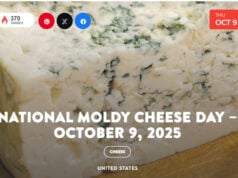
Join National Rum Day on August 16th as blended beverages and cocktails create a delicious celebration. Rum is a distilled clear alcoholic beverage that is a byproduct of sugar production. It can also be made directly from sugar cane juice. After the fermentation and distillation process, most rum ages in wooden oak barrels.
- 1600s – In the West Indies during the 1600s, large plantations grew sugar cane. When they extracted the sugar, they created a by-product called molasses. For years, molasses was a waste product until it was discovered that it could be distilled into rum.
- 1620s – Molasses, a byproduct of sugar production, was distilled into a spirit that would eventually be called rum.
- 1655 – When the British navy captured Jamaica in 1655, it had access to domestically produced rum, leading to the daily liquor ration of sailors of rum over the more expensive brandy.
- 1664 – The first distillery in what would become the continental U.S. is founded on Staten Island.
- 1703 – Mount Gay is a world-renowned rum distillery in Barbados. It has been producing this liquor since 1703, making it the world’s oldest distillery.
- 1764 – The 1764 tax on Sugar and molasses created significant tension between British colonists and the home country.
- 1780 – The oldest known rum is The Harewood Rum 1780, believed to have been distilled in Barbados in 1780. In 2011, fifty-nine bottles of the previously forgotten rum were discovered in the basement of Harewood House, Leeds, UK.
- 1789 – George Washington insisted on a barrel of Barbados rum being available at his 1789 inauguration
- 1805 – Nelson’s Blood: Legend has it that after Admiral Nelson died in 1805 at the Battle of Trafalgar, his body was placed in a cask of rum to preserve it for the journey home. However, sailors drilled holes in the cask to get to the rum. Essentially, sailors drank rum mixed with blood, leading to the famous name today.
- 1806 – The Gosling family of rum makers have been supplying the world with this storied beverage since 1806, aging and blending every drop on their home island of Bermuda.
- 1824 – The origin of the word “rum” is generally unclear. In an 1824 essay about the word’s origin, Samuel Morewood, a British etymologist, suggested it might be from the British slang term for “the best”, as in “having a rum time.” He wrote: As spirits, extracted from molasses, could not well be ranked under the name whiskey, brandy, or arrack, it would be called rum, to denote its excellence or superior quality.
- 1850s – The Gosling family released their first barrels of what they called “old rum,” a secret blend of three rums aged in “once used” bourbon barrels.
- 1864 – The first distillery in what would become the continental U.S. is founded on Staten Island
- 1914 – Many years later a play on words and images gave birth to the little, barrel-juggling “Black Seal” logo and a name change to Goslings Black Seal Rum.
- 1970 – Even in the modern Royal Navy, British sailors received an allotment of rum until 1970.
- 2011 – Fifty-nine bottles of the previously forgotten “The Harewood Rum 1780” rum were discovered in the basement of Harewood House, Leeds, UK.
- Florida ranks as the 2nd most rum-loving state, behind New York.
- Rum is the third most popular spirit in the United States. Only vodka and all the whiskeys combined beat it for first and second rankings.
- The spirit finds its way into citrusy mixed drinks and cool blended summer cocktails. So much so, that rum stirs up images of sandy beaches and brightly colored umbrellas in fruity drinks.
- Rum’s association with piracy began with British privateers trading on the valuable commodity. As some of the privateers became pirates and buccaneers, their fondness for rum remained; the association between the two only being strengthened by literary works such as Robert Louis Stevenson’s Treasure Island.
- Initially called “kill devil” for its high alcohol content and less-than-savory taste, the process of fermenting and distilling molasses became steadily more sophisticated, and the spirit significantly more enjoyable.
- The etymology of the word “rum” is still open for debate, but among the most agreed upon theories is that it is derived from the terms rumbuillion or rumbustion — both meaning an upheaval — but eventually shortened to rum.
- The difference between the shades of rum depends entirely on aging. Light rums are aged very little, if at all. Dark rums are aged from 5-10 years, depending on the climate. Golden rum is aged longer than light rum but not nearly as long as dark rum.
- George Washington made his Mount Vernon Eggnog with dark Jamaican rum, much to the delight of all his guests.
- Wray and Nephew Overproof Rum has a whopping 63% ABV, you might want to take it easy with this one.
- If you’re up for a challenge, consider a bottle of Sunset Very Strong Rum, which clocks in at 84.5% ABV. The prize goes to Suriname’s Marienburg Rum with 90% ABV.
- Many people believe that rum can help with hair growth! Many men and women who have noticed thinning locks have turned to rum in an attempt to slow down hair loss. Generally, practitioners use rum as a shampoo, though, and don’t drink it for this benefit.
- Nicknames are fairly common for people. But have you heard any of these nicknames for rum? Kill-Devil, Demon Water, Navy Neaters, Nelson’s Blood, Barbados Water, Grog, Pirates Drink, or Rumbuillion.
- As rum is aged in casks, a little bit evaporates. This missing amount has come to be known as the angel’s share.
- Rum gets drier with age, not sweeter.
- In colonial times, rum was sometimes used as currency to pay sailors.
- Early sailors believed that its antioxidant properties could fight off scurvy and vitamin-deficiency diseases.
Sources:
Disclaimer
The information contained in South Florida Reporter is for general information purposes only.
The South Florida Reporter assumes no responsibility for errors or omissions in the contents of the Service.
In no event shall the South Florida Reporter be liable for any special, direct, indirect, consequential, or incidental damages or any damages whatsoever, whether in an action of contract, negligence or other tort, arising out of or in connection with the use of the Service or the contents of the Service. The Company reserves the right to make additions, deletions, or modifications to the contents of the Service at any time without prior notice.
The Company does not warrant that the Service is free of viruses or other harmful components












